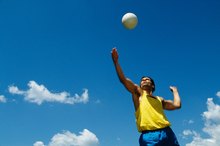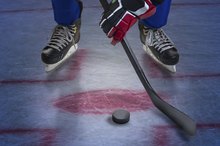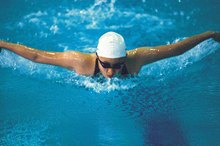Forearm Pain After Throwing a Baseball
If you repeatedly perform overhead throws at high speeds, it can put tremendous pressure on your elbow. In addition, tight forearm muscles compound the stress on your elbow because your elbow has to compensate for a restricted range of motion. Various problems, such as overuse, overload, muscle tightness and poor throwing form, can lead to the inflammation of the tendons around your throwing elbow, causing the pain in your forearm.
If you are experiencing serious medical symptoms, seek emergency treatment immediately.
The Downside of a Wrist Snap
The rapid wrist snap in an overhead pitch requires resisted wrist flexion and the pronation -- the movement from a palm-up to palm-down position -- of your forearm. Overusing the tendons around the medial or inner side of your elbow, which generates the wrist snap, can lead to inflammation and tendonitis. Known as golfer’s elbow, medial epicondylitis is the degeneration of your arm’s flexor tendon resulting from the overuse of excessive force on a wrist snap. If you’re feeling pain on the inside of your forearm and it extends from your elbow to your pinky finger, it is recommended that you ask your doctor to look at the injury for flexor tendon damage, according to New York-Presbyterian Hospital.
- The rapid wrist snap in an overhead pitch requires resisted wrist flexion and the pronation -- the movement from a palm-up to palm-down position -- of your forearm.
- If you’re feeling pain on the inside of your forearm and it extends from your elbow to your pinky finger, it is recommended that you ask your doctor to look at the injury for flexor tendon damage, according to New York-Presbyterian Hospital.
A Stretched Nerve
Reasons for Arm Pain During Volleyball
Learn More
When you bend your elbow, the ulnar nerve stretches around the bump at the end of your upper-arm bone, or humerus. Every time you pitch a baseball, that nerve has to stretch. Overuse can lead to a condition known as ulnar neuritis, or an irritated nerve. You’ll feel a tingling pain that begins at your elbow and travels into your forearm. Other symptoms include a tingling or numbness in your ring and pinky fingers during or after a pitch. Overuse can even cause the ulnar nerve to slide out of place and snap. This condition is often associated with medial epicondylitis, according to “Magnetic Resonance Imaging in Orthopaedics and Sports Medicine” by David Stoller 67.
- When you bend your elbow, the ulnar nerve stretches around the bump at the end of your upper-arm bone, or humerus.
- Other symptoms include a tingling or numbness in your ring and pinky fingers during or after a pitch.
Contributing Factors
Elbow injuries and forearm pain have a strong correlation to the number of pitches you throw, innings you pitch and months you play. In addition, the more force you use on a pitch, the more vulnerable you are to these injuries. If you’re bending your arm too early or too late in the throw, it can put excessive stress on your elbow and forearm. An example of improper form is leading with your elbow and pushing the ball with your forearm instead of using your shoulder to execute a pitch. Adjusting your warm-up routine can help to reduce your risk of injury. As opposed to a hand grip that only works your wrist, use rubber tubing to warm and stretch both your wrist and forearm.
- Elbow injuries and forearm pain have a strong correlation to the number of pitches you throw, innings you pitch and months you play.
- As opposed to a hand grip that only works your wrist, use rubber tubing to warm and stretch both your wrist and forearm.
Addressing the Pain
Wrist Pain from Hockey
Learn More
If you’re feeling forearm pain after throwing a baseball, the first step is to stop throwing and rest your throwing arm. Apply ice and elevate your arm if you’re experiencing any swelling or inflammation. Visit your doctor to figure out the source of the pain. He or she may prescribe anti-inflammatory medications to alleviate the pain. Have your coach evaluate your throwing form and correct any flaws contributing to stress on your elbow. While your arm recovers, you may have to limit your throwing and do cardiovascular work to maintain physical conditioning.
- If you’re feeling forearm pain after throwing a baseball, the first step is to stop throwing and rest your throwing arm.
- While your arm recovers, you may have to limit your throwing and do cardiovascular work to maintain physical conditioning.
Related Articles
References
- American Academy of Orthopaedic Surgeons: Elbow Injuries in the Throwing Athlete
- Principles of Manual Sports Medicine; Steven J. Karageanes, Editor
- TheCompletePitchercom.: Pitching Injuries
- Pitching.com: How to Avoid Elbow and Shoulder Pitching Injuries Before It’s Too Late
- ESPN: Baseball Injuries 101: Sprains, Strains and Other Pains
- Magnetic Resonance Imaging in Orthopaedics and Sports Medicine; David W. Stoller, Editor
- Houston Methodist Orthopedics & Sports Medicine: Medial Epicondylitis
- Vaquero-picado A, Barco R, Antuña SA. Lateral epicondylitis of the elbow. EFORT Open Rev. 2016;1(11):391-397. doi:10.1302/2058-5241.1.000049
- Amin NH, Kumar NS, Schickendantz MS. Medial epicondylitis: evaluation and management. J Am Acad Orthop Surg. 2015;23(6):348-55. doi:10.5435/JAAOS-D-14-00145
- Blackwell JR, Hay BA, Bolt AM, Hay SM. Olecranon bursitis: a systematic overview. Shoulder Elbow. 2014;6(3):182-90. doi:10.1177/1758573214532787
- Truong J, Ashurst JV. Septic Bursitis. Treasure Island, Fl: StatPearls Publishing; 2019.
- Varacallo M, Mair SD. Proximal Biceps Tendinitis and Tendinopathy. Treasure Island, Fl: StatPearls Publishing; 2019.
- Bellapianta JM, Lavelle WF, Lavelle ED, Onyedika I, Economedes D, Whipple R. Hand Pain. Current Therapy in Pain. 2009:156-167. doi:10.1016/b978-1-4160-4836-7.00021-3
- Moradi A, Ebrahimzadeh MH, Jupiter JB. Radial Tunnel Syndrome, Diagnostic and Treatment Dilemma. Arch Bone Jt Surg. 2015;3(3):156-62.
- Saeed W, Waseem M. Elbow Fractures Overview. Treasure Island, Fl: StatPearls Publishing; 2019.
- Athwal GS. Elbow Dislocation - OrthoInfo - AAOS. OrthoInfo: American Academy of Orthopaedic Surgeons. Oct 2017.
- Bursitis. MedlinePlus. Sept 12, 2019.
- Harvard Health Publishing. The importance of stretching. Harvard Health. Sept 2013.
- Tennis Elbow (Lateral Epicondylitis) - OrthoInfo - AAOS. OrthoInfo: American Academy of Orthopaedic Surgeons. Jul 2015.
- Shah CM, Calfee RP, Gelberman RH, Goldfarb CA. Outcomes of rigid night splinting and activity modification in the treatment of cubital tunnel syndrome. J Hand Surg Am. 2013;38(6):1125-1130.e1. doi:10.1016/j.jhsa.2013.02.039
- Biceps Tendinitis - OrthoInfo - AAOS. OrthoInfo: American Academy of Orthopaedic Surgeons. Feb 2016.
- Kinaci A, Neuhaus V, Ring D. Surgical procedures of the elbow: a nationwide cross-sectional observational study in the United States. Arch Bone Jt Surg. 2015;3(1):13-8.
- American Academy of Orthopedic Surgeons. (n.d.). Elbow Arthroscopy.
- Kane SF. Evaluation of Elbow Pain in Adults. Am Fam Physician. 2014 Apr 15;89(8):649-57.
- O'Connor FG. (2018). Evaluation of elbow pain in adults. Fields KB, ed. UpToDate. Waltham, MA: UpToDate Inc.
- Sources:American Academy of Orthopedic Surgeons (n.d.). Elbow Fractures in Children.
Writer Bio
Kay Tang is a journalist who has been writing since 1990. She previously covered developments in theater for the "Dramatists Guild Quarterly." Tang graduated with a Bachelor of Arts in economics and political science from Yale University and completed a Master of Professional Studies in interactive telecommunications at New York University.








